This was published 7 years ago
Kyoto walking tour: Samurai Joe's terrifying sword trick
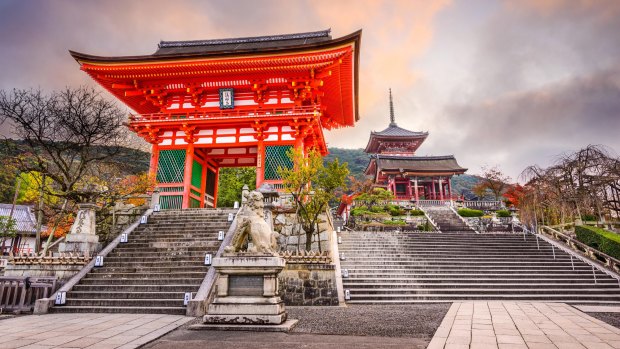
Morning light at Kiyomizu Temple, Kyoto. Credit: Alamy
Brian looks concerned. "Don't worry," says Joe. "I have done this 3000 times and only made one mistake."
If I were Brian, I'd be concerned, too. Joe is about to attempt to cut through a radish and an apple balanced on his stomach using a razor-sharp samurai sword. The reason he's done it 3000 times is because he's 86 years old.
The trick is the culmination of an impressive samurai show held in the courtyard of Shimogoryo Shrine in Kyoto. First, Joe demonstrates how he would defend himself against an ever-increasing number of attackers. One person? Butt of the sword into the stomach. Two people? Butt into the stomach of the first person, then swipe across the midriff of the second (remembering to wipe the blood off the blade afterwards, of course). Five people? "Turn around and run," he says, scampering off towards the bushes.
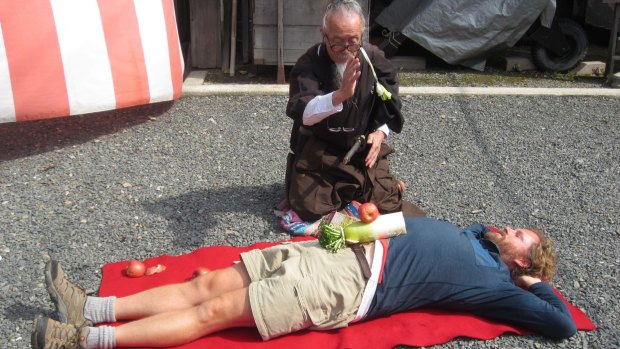
Joe prepares to perform a samurai sword trick.Credit: Rob McFarland
Next he assembles a vertical rack of wooden sticks, carefully spacing them a few centimetres apart. He explains that he will cut through them one at a time, thereby demonstrating his precise sword control. "If I cut more than one, I have to commit hara-kiri." On his second attempt, he cuts two. "Oh well," he says, shrugging. "No one's perfect."
Several tricks involve a worrying degree of audience participation. Joe asks for a volunteer and I find myself apprehensively holding the top of a two-metre-long piece of bamboo. Moments later there's a blood-curdling "Hi-yah!" and he's sliced it in two. Other "volunteers" have radishes chopped out of their hands and toss apples into the air that are sliced mid-flight (well, most of them). However, this all pales by comparison with the commitment required by Brian, the human chopping board.
Joe kneels over him and slowly lowers the glinting sword, carefully lining it up with the fruit and veg stacked precariously on his midriff. Brian's wife looks on in terrified silence, while his two young children peek through splayed fingers. Joe raises the sword above his head, lets out another loud "Hi-yah!", then brings it down in a flash, cutting clean through the apple and radish but leaving Brian intact. We all breathe a collective sigh of relief.
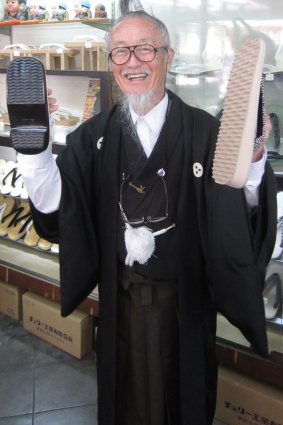
Smiling assassin: Samurai Joe.Credit: Rob McFarland
A sword demonstration by an octogenarian samurai is just one of the surprises on this entertaining walking tour of Kyoto. Most tours focus on the city's illustrious history – its 17 UNESCO World Heritage sites and the centuries-old traditions of shoguns and geishas. Not this one. It presents the city as it is today, via a leisurely four-kilometre stroll interspersed with visits to independent stores and artisans.
We first meet "Samurai" Joe outside Kyoto's imposing City Hall. He's easy to spot, thanks to his flowing brown kimono, wispy grey beard and hair pulled back into a traditional samurai top knot. There are eight of us on today's tour – me; Brian, his wife and two children from Canada; a couple from Melbourne and a young lady from Taiwan.
Over the next few hours we get an intriguing insight into contemporary Kyoto life. We visit around a dozen stores – small, family-run establishments selling everything from exquisite handmade rugs to old-fashioned wooden sandals.
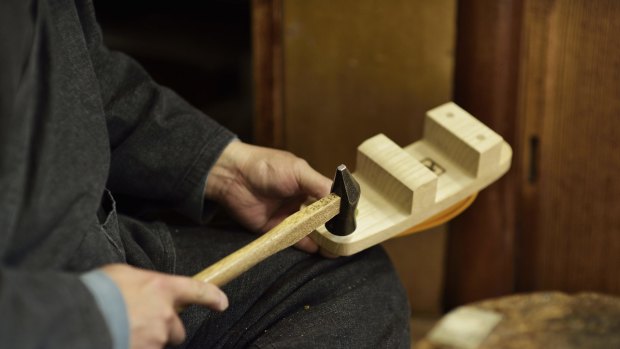
Geta, Japanese-made wooden clogs.Credit: Yagi Studio
En route, we sample a variety of local delicacies including freshly made inari sushi (triangles of rice covered in tofu), green tea-flavoured boiled sweets and chest-warming cups of sake.
We call into an art supplies store where Joe shows us how to write our names in Japanese characters using a paintbrush and black ink, then give us marks for our attempts to copy them.
In a flower store we marvel at shelves full of intricate floral arrangements in delicate shades of pink, mauve and coral. Joe shows us a refrigerator full of roses in a rainbow of colours, then points out the price – ¥800 each. "Lucky my wife likes camellias," he says, winking.
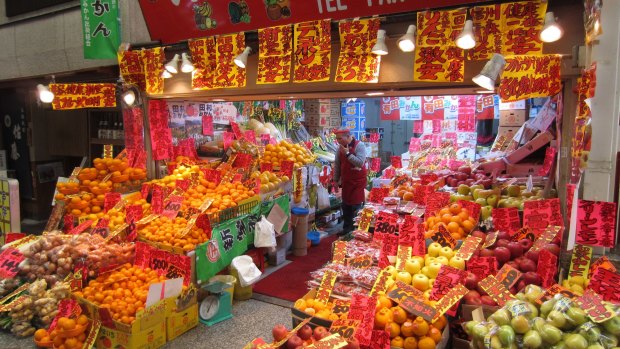
Fruit shop in Demachi Masugata.Credit: Rob McFarland
In addition to visiting Shimogoryo, a Shinto shrine with a striking red "torii" entrance gate and a courtyard full of blossoming plum trees, we also call into Gyoganji, a Buddhist temple that dates back to 1004.
Inside Gyoganji are dozens of ornate wooden thank-you letters from people who claim they received miracles after their visit. Joe guides us through the traditional prayer offering and then introduces the temple's spritely 90-year-old attendant. "She has four years on me," he says affectionately.
As we stroll along Kyoto's streets, Joe tells us about life in the city – how difficult it is to get a driver's licence; the diminutive dimensions of the average apartment; the crippling price of real estate. We also learn a little more about him. Forbidden from studying English during World War II ("it was the tongue of the enemy"), he eventually learnt it after Japan surrendered in 1945. After a stint in the US as a tour guide, he returned to Kyoto and created the "Samurai Nippon Show", a spectacular theatre production staged in a castle south of the city. He reckons he performed 1700 shows during his 14-year stint as the resident samurai, a tenure that brought him international acclaim and an appearance on the David Letterman show.
He's been running this tour for four years now and his vitality, enthusiasm and good humour are an inspiration. He's excited about the upcoming Olympic Games and fully intends to continue working. "If I can keep going until 2020," he says, proudly, "I will be the only guide to experience both Tokyo Olympics."
As we sit on plastic crates eating succulent salmon and tuna sashimi, I ask Joe what's his secret. How has he lived such a long and healthy life? "Simple," he says, lowering his voice to a conspiratorial whisper, "19 cups of sake a day."
TRIP NOTES
MORE INFORMATION
GETTING THERE
ANA flies direct from Sydney to Tokyo's Haneda airport using the latest Boeing 787-900 Dreamliner. Tokyo to Kyoto by bullet train takes just over two hours. See ana.co.jp
STAYING THERE
On the banks of the Kamogawa River, the Ritz-Carlton Kyoto is an elegant fusion of traditional Japanese design, upscale amenities and flawless service. The 134-room property features four restaurants, a decadent spa and is ideally positioned for exploring the city on foot. Rooms from ¥73,000. See ritzcarlton.com
TOURING THERE
The Cool Kyoto Walking Tour with Samurai Joe runs every Saturday from 10am-3pm and includes several tastings plus a light lunch. The distance covered is roughly four kilometres. Cost ¥3000 per person. Bookings recommended. See cool-kyoto.net.
FIVE MORE BEHIND-THE-SCENES TOURS IN KYOTO
FORAGE AND FEAST
Explore Kyoto's rich culinary scene with a bespoke itinerary created by food writer Jane Lawson from Zenbu Tours. Options include visits to local markets, tours of family-run food suppliers and meals at some of the city's best restaurants. See www.zenbutours.com.
TEMPLE TASTER
Learn more about Buddhism while exploring the impressive 1200-year-old Kiyomizu-dera Temple with an English speaking priest. The tour includes access to areas that are normally off-limits, such as the inner sanctuary of the Main Hall and the Taho-kaku, a sacred building containing a black marble engraving of Buddha's footprints. See www.kiyomizudera.or.jp/en.
DINE WITH MAIKOS
Enjoy an authentic Kaiseki dinner while being entertained by a maiko (a trainee geisha) at the elegant Gion Hatanaka Ryokan. Performances include traditional songs, dances and drinking games (don't expect to win), but the real treat is being able to quiz them about life as a modern-day maiko. See www.thehatanaka.co.jp/english.
QUIETEN THE MIND
Shunkoin Zen Buddhist Temple is one of the only temples in the city to offer guided meditation classes in English. Led by the entertaining Deputy Priest Rev. Takafumi Kawakami, the sessions teach the principles and practical applications of this age-old practice in a refreshingly down-to-earth way. See www.shunkoin.com.
ARTISAN CONCIERGE
Create your own tour of Kyoto's extensive network of artisans using a new website from the city's tourism office. The site provides information on dozens of local ateliers where you can see traditional crafts such as Nishijin weaving, Yuzen dyeing and wood block printing. See www.kyotoartisans.jp/en .
Rob McFarland was a guest of Kyoto Convention & Visitors Bureau, the Ritz-Carlton Kyoto and the International Luxury Travel Market.
Sign up for the Traveller Deals newsletter
Get exclusive travel deals delivered straight to your inbox. Sign up now.